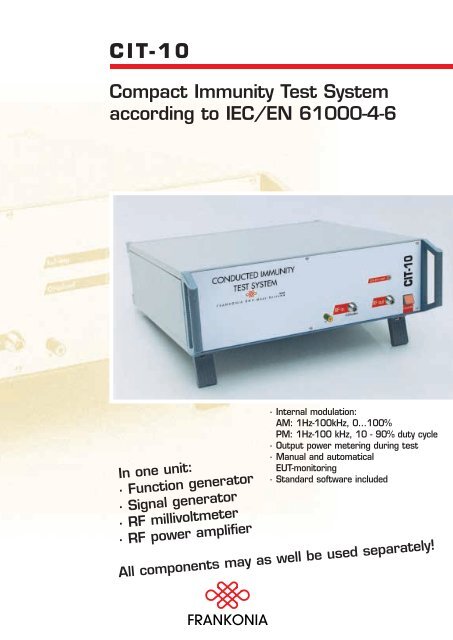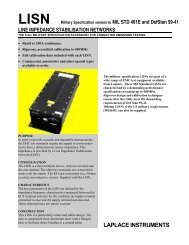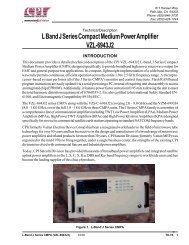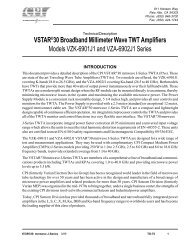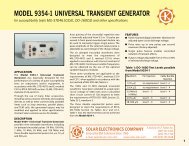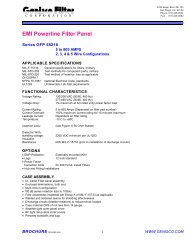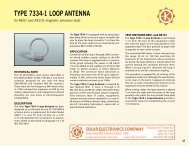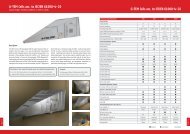CIT-10 Compact Immunity Test System according to IEC/EN 61000-4-6
CIT-10 Compact Immunity Test System according to IEC/EN 61000-4-6
CIT-10 Compact Immunity Test System according to IEC/EN 61000-4-6
- No tags were found...
Create successful ePaper yourself
Turn your PDF publications into a flip-book with our unique Google optimized e-Paper software.
<strong>CIT</strong>-<strong>10</strong><strong>Compact</strong> <strong>Immunity</strong> <strong>Test</strong> <strong>System</strong><strong>according</strong> <strong>to</strong> <strong>IEC</strong>/<strong>EN</strong> 6<strong>10</strong>00-4-6In one unit:· Function genera<strong>to</strong>r· Signal genera<strong>to</strong>r· RF millivoltmeter· RF power amplifier· Internal modulation:AM: 1Hz-<strong>10</strong>0kHz, 0...<strong>10</strong>0%PM: 1Hz-<strong>10</strong>0 kHz, <strong>10</strong> - 90% duty cycle· Output power metering during test· Manual and au<strong>to</strong>maticalEUT-moni<strong>to</strong>ring· Standard software includedAll components may as well be used separately!
st <strong>System</strong> <strong>according</strong>6<strong>10</strong>00-4-6Is a suitable measuring instrument connected <strong>to</strong> the specifiedserial port of the <strong>CIT</strong>-<strong>10</strong>, EUT can be moni<strong>to</strong>red au<strong>to</strong>matically.Data are shown graphically. During all test routines the amplifieroutput is moni<strong>to</strong>red in a bar display. This guaratees correcttests.In the case of , a test is performed over the completeselected frequency range; in this case the test frequency isincreased by the control software <strong>according</strong> <strong>to</strong> the selected stepwidth and the entered dwell time. If there is a malfunction of theEUT, the test may be s<strong>to</strong>pped at any time. It is then possible <strong>to</strong> offers the possibility of testing the EUT at discretefrequencies. This can be done either with a fixed test voltageor, optionally, with a ramp function. In case of the ramp function,the start and s<strong>to</strong>p voltage, the step width by which the testvoltage is <strong>to</strong> be increased, as well as the dwell time between theindividual steps may be preset by the tester.The standard consists of the head of the pro<strong>to</strong>col anda diagram which shows the test results. In the head of the pro<strong>to</strong>colthe date and time are taken over from the computer; inaddition, details like temperature, air humidity, tester, as well astesting set-up and EUT, may be registered. The pro<strong>to</strong>col maybe printed directly. Additionally it is possible <strong>to</strong> edit the pro<strong>to</strong>colindividually.either increase or reduce the frequency by any number of steps,as well as <strong>to</strong> switch on and off the modulation and test voltage.Besides, a description of the malfunction occurred may be enteredin a comment line which is included in the test record.Most common Coupling/Decoupling Networks (CDNs), 150kHz <strong>to</strong> 230MHz:Type: Use for: Number of lines Type of connectionCDN-M1 unshielded mains supplies 1 4mm MC socketCDN-M2 unshielded mains supplies 2 4mm MC socketCDN-M3 unshielded mains supplies 3 4mm MC socketCDN-M2+3 unshielded mains supplies 2 or 3 4mm MC socketCDN-M5 unshielded mains supplies 5 4mm MC socketCDN-S1 shielded lines 1 BNCCDN-S2 shielded lines 2 XLRCDN-S9 shielded lines 9 9 pole Sub-DCDN-S25 shielded lines 25 25 pole Sub-DCDN-AF2 asymmetric lines 2 connec<strong>to</strong>r blockCDN-AF8 asymmetric lines 8 connec<strong>to</strong>r blockCDN-T2 symmetric lines 2 connec<strong>to</strong>r blockCDN-T4 symmetric lines 4 connec<strong>to</strong>r blockCDN-T8 symmetric lines 8 connec<strong>to</strong>r blockEM coupling clamp:The EM coupling clamp is used in all cases where CDNs are notadvisable or not available. The lines <strong>to</strong> be tested are in this caseinserted in the clamp and the test voltage is injected inductively.
Technical Data:Signal genera<strong>to</strong>r incl. function genera<strong>to</strong>rFrequency range<strong>10</strong>0kHz <strong>to</strong> 250MHzResolution 1HzOutput level-60dBm <strong>to</strong> 0dBmResolution 0.1 dBDis<strong>to</strong>rtionsHarmonic 13W (<strong>CIT</strong>-<strong>10</strong>), 75W (<strong>CIT</strong>-<strong>10</strong>/75)Dis<strong>to</strong>rtions


